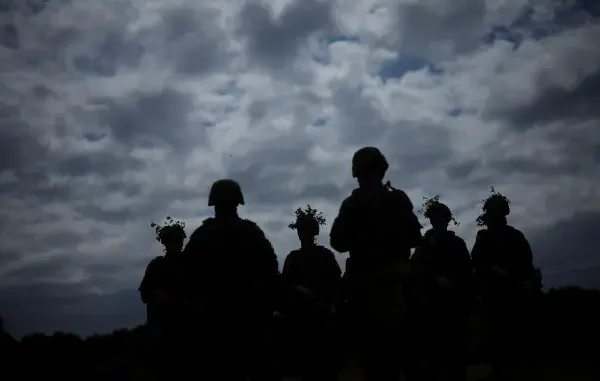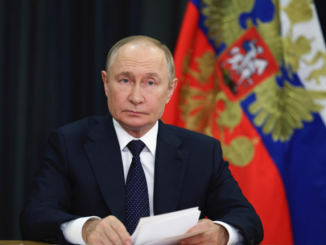
Volunteers train alongside professional soldiers and can enlist to be embedded in regular units.
Published September 13, 2025
POLAND has deployed 40,000 troops to its eastern front as Vladimir Putin launches his WW3 drills in Belarus.
Amid escalating fears of Russian aggression, thousands of Poles are enlisting in voluntary military training programs, reflecting a surge in civic readiness unprecedented in recent decades. This movement is fueled by heightened tensions following Russia’s invasion of Ukraine and a recent drone incursion into Polish airspace.
Surge in Volunteer Military Training
By mid-2025, over 20,000 civilians had enrolled in Poland’s voluntary military training initiatives, with projections indicating this number could double by the end of the year. These programs aim to bolster Poland’s defense capabilities by training civilians to support the professional military, forming a rapid-response reserve force. Participants, such as office administrator Agnieszka Jedruszak, are undergoing intensive training, including trench digging and camouflage techniques, to prepare for potential conflict. Jedruszak emphasized her commitment to protecting her family and homeland, stating, “I’d do anything to keep my child safe.”
Strategic Military Enhancements
In response to the growing threat, Poland has significantly increased its defense spending, allocating 4.7% of its GDP to military expenditures—the highest percentage among NATO countries. The government is restructuring its armed forces to enhance mobility, surveillance, and readiness, including constructing a fortified “East Shield” along the eastern border and relocating military units to this region. Additionally, Poland has mobilized 40,000 troops and sealed its eastern border in reaction to Russia’s Zapad-2025 military drills in Belarus, which simulate large-scale military campaigns and have previously included scenarios of Russian attacks on NATO countries.
Drone Incursion and NATO Response
A pivotal moment in the escalating tensions occurred on September 9, 2025, when 19 to 23 Russian drones entered Polish airspace, triggering a Quick Reaction Alert by the Polish Air Force and NATO allies. Several drones were shot down, and airspace over key airports was temporarily closed. Polish Prime Minister Donald Tusk described the incident as a direct threat, while Deputy Prime Minister Radosław Sikorski stated it was an unprecedented attack on both Poland and NATO territory. In response, NATO invoked Article 4 consultations, marking the closest the alliance has come to direct confrontation with Russia since the Ukraine invasion began in 2022.
People in Poland like, Agnieszka Jedruszak, are heading to military training in anticipation of war with Russia.REUTERS
A car damaged by debris from the roof next to a destroyed house after Russian drones violated Polish airspace during an attack on Ukraine, with some being shot down by Poland on Wednesday.REUTERS
https://youtu.be/8offho-lxnc?si=nYKx2UgYX6u3vdn7
 Implications
Implications
1. National Security Implications
-
Increased Readiness: The surge in civilian military training strengthens Poland’s defensive capabilities by creating a larger pool of trained individuals who can support professional troops in emergencies.
-
Deterrence Signal: Demonstrates to Russia that Poland is prepared for potential aggression, potentially deterring immediate hostile actions.
-
Civil-Military Integration: Encourages collaboration between civilians and military institutions, fostering a culture of preparedness.
2. Regional Security and NATO
-
NATO Tensions: The Russian drone incursion and Poland’s defensive measures (border closure, troop deployment) could heighten tensions in Eastern Europe and test NATO’s rapid response mechanisms.
-
Alliance Solidarity: Poland’s actions may push NATO allies to increase support and surveillance in the region, strengthening collective defense.
-
Escalation Risk: The buildup may also provoke Russia to intensify military drills near the border or conduct further incursions, raising the risk of miscalculation.
3. Political Implications
-
Domestic Politics: Polish leaders may gain political capital by demonstrating proactive defense measures, appealing to nationalist sentiment.
-
International Diplomacy: Poland may leverage its readiness to demand stronger international sanctions or support against Russian aggression.
-
Policy Precedent: Encouraging civilians to train for war could influence defense policies in other nations facing potential threats.
4. Social Implications
-
Public Anxiety: The fear of Russian attacks is prompting widespread mobilization, reflecting heightened public anxiety about security.
-
Community Engagement: Voluntary training fosters a sense of responsibility and civic engagement among citizens.
-
Mental Health Considerations: Continuous focus on potential conflict may affect societal morale and stress levels.
5. Economic Implications
-
Defense Spending: Poland’s allocation of 4.7% of GDP to defense may strain the national budget but could boost local defense industries.
-
Opportunity Costs: Resources diverted to defense might limit investment in other sectors, such as healthcare or infrastructure.
-
Labor Impacts: Civilian participation in training programs may temporarily reduce workforce availability in some areas.
6. Long-Term Strategic Implications
-
Resilience Building: The development of a trained civilian reserve strengthens long-term national resilience against hybrid or conventional threats.
-
Precedent for Other Nations: Other countries bordering Russia or in volatile regions may adopt similar civilian training programs.
-
Escalation or Stability: Depending on diplomatic responses, this mobilization could either stabilize the region through deterrence or increase the risk of an accidental conflict.
Broader Implications
The surge in volunteer military training and Poland’s strategic military enhancements underscore the nation’s commitment to self-defense and regional security. These developments also reflect broader concerns among NATO members about Russia’s intentions and the alliance’s readiness to respond to potential threats. As Poland continues to bolster its defense capabilities, it serves as a critical example of national resilience and the importance of civic engagement in safeguarding sovereignty.
 Overall Takeaway:
Overall Takeaway:
The unprecedented surge in civilian military training in Poland reflects more than just a reaction to immediate threats—it signals a profound shift in national consciousness. Faced with the specter of Russian aggression, Polish citizens are stepping up to take an active role in the defense of their homeland, demonstrating a remarkable level of civic responsibility and resilience. This movement underscores the critical importance of preparedness in an era of unpredictable geopolitical tensions, where the lines between conventional warfare, hybrid threats, and strategic intimidation are increasingly blurred.
Poland’s proactive measures—ranging from increased defense spending and fortified borders to the mobilization of tens of thousands of troops—serve as both a deterrent to potential aggressors and a reassurance to NATO allies that the alliance’s eastern flank is vigilant. Yet, this heightened state of readiness also carries risks: public anxiety may rise, regional tensions could escalate, and the shadow of conflict may loom over everyday life.
Ultimately, Poland’s response is a case study in the power of national unity and civic engagement in safeguarding sovereignty. It highlights that in today’s security landscape, the defense of a nation is not solely the responsibility of professional armed forces—it is a collective endeavor that encompasses ordinary citizens willing to stand ready in the face of uncertainty. For Poland, the lessons are clear: resilience, preparation, and a vigilant populace are as vital to national security as tanks, aircraft, or fortifications. The coming months will test the effectiveness of this strategy, but the message is unmistakable—Poland is prepared, and its people are determined to defend their nation at any cost.
SOURCES: THE NEW YORK POST – Thousands in Poland sign up for military training over fears of Russia attack
HOMOLULU STAR ADVISER – Fearful of Russian attack, Polish citizens flock to military training
REUTERS – Fearful of Russian aggression, Poles flock to military training
THE UK SUN – BARBED WIRE CURTAIN Poland seals eastern border & deploys 40,000 troops as Putin and dictator pal begin war games on West’s doorstep








Be the first to comment